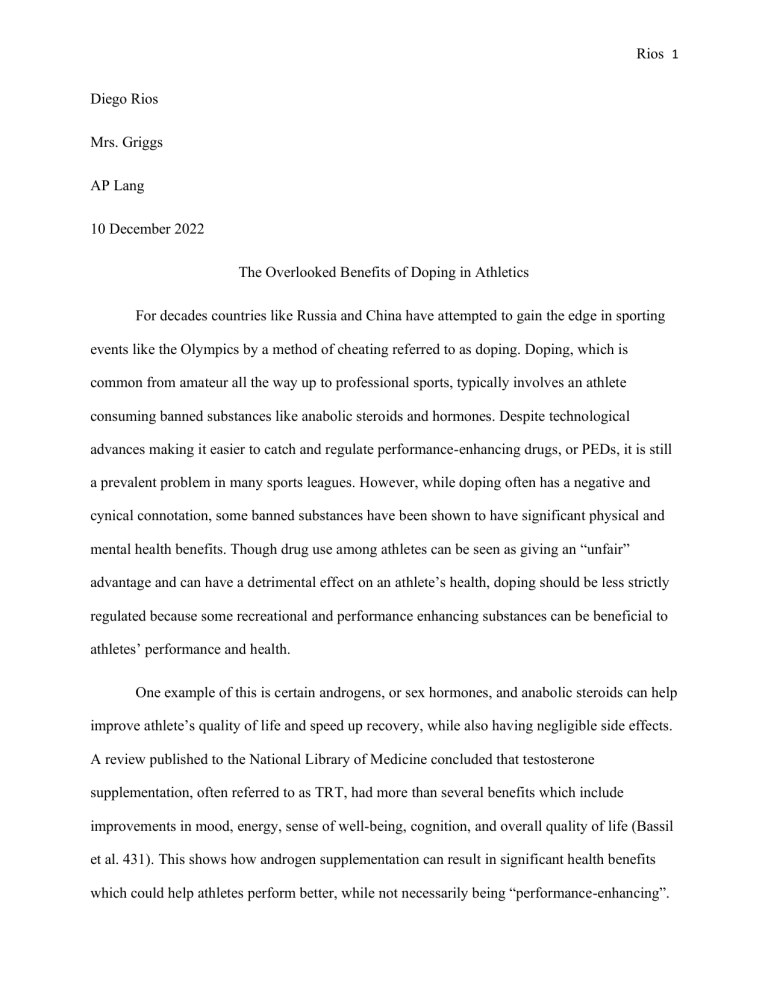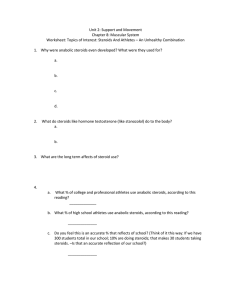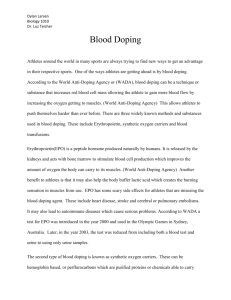
Rios 1 Diego Rios Mrs. Griggs AP Lang 10 December 2022 The Overlooked Benefits of Doping in Athletics For decades countries like Russia and China have attempted to gain the edge in sporting events like the Olympics by a method of cheating referred to as doping. Doping, which is common from amateur all the way up to professional sports, typically involves an athlete consuming banned substances like anabolic steroids and hormones. Despite technological advances making it easier to catch and regulate performance-enhancing drugs, or PEDs, it is still a prevalent problem in many sports leagues. However, while doping often has a negative and cynical connotation, some banned substances have been shown to have significant physical and mental health benefits. Though drug use among athletes can be seen as giving an “unfair” advantage and can have a detrimental effect on an athlete’s health, doping should be less strictly regulated because some recreational and performance enhancing substances can be beneficial to athletes’ performance and health. One example of this is certain androgens, or sex hormones, and anabolic steroids can help improve athlete’s quality of life and speed up recovery, while also having negligible side effects. A review published to the National Library of Medicine concluded that testosterone supplementation, often referred to as TRT, had more than several benefits which include improvements in mood, energy, sense of well-being, cognition, and overall quality of life (Bassil et al. 431). This shows how androgen supplementation can result in significant health benefits which could help athletes perform better, while not necessarily being “performance-enhancing”. Rios 2 Because of this, androgens should be a large factor to consider by anti-doping agencies when it comes to the wellbeing of their athletes. In a study conducted on rats by the Yale School of Medicine, they found that anabolic steroids may “enhance the healing process” and “aid in the healing of muscle contusion [bruise] injury”, concluding that anabolic steroids could potentially have an “ethical clinical application” in regard to muscle damage (Beiner et al. 2, 9). While the androgen research proved to have notable mental and cognitive health advantages, anabolic steroids have been shown to provide considerable physical health benefits like efficiently healing injuries. Due to this, athletes could hypothetically minimize the number of injuries they endure and the amount recovery time they need. This, along with the benefits androgens provide, demonstrates potential reasons doping should be less strictly regulated. Despite steroids being the most commonly used and abused substances by athletes, they aren’t the only thing that WADA and other anti-doping organizations are looking for; some substances, namely growth hormone peptides, can improve bodily functions such as the healing process while possessing minimal side effects. According to an article from Healthline by Alina Petre, a sports medicine dietician, peptides can have very remarkable and beneficial effects, and can even, “prevent blood clots, boost the immune system, protect cells against damage, and reduce cholesterol, inflammation, and blood pressure.” This shows how peptides, despite being a banned substance by anti-doping agencies, can provide a plethora of positive health benefits which could improve athletes’ health and prevent injury. Because of these benefits, athletes and coaches should push for reconsideration of the anti-doping policies when it comes to peptides. In reference to the same article, side effects from peptides appear to be minimal and have no longlasting effects; on the contrary, temporary effects like increased appetite, elevated blood sugar levels, fluid retention, and increased insulin sensitivity appear to be prevalent (Petre). However, despite these common side effects, symptoms are very minor and can easily be managed, unlike Rios 3 side effects from anabolic steroids. Because the risk to reward ratio is very favorable, peptides make for a great supplement for athletes and further supports why doping needs to be regulated less. However, though performance enhancing substances are often the key suspects when it comes to doping, certain recreational drugs also tend to get athletes in trouble. Marijuana, a drug that is for the most part legal in the United States and in over 30 countries worldwide, can potentially be beneficial to athletes as it has been shown to reduce stress and improve the focus of users. According to research conducted by Susan Stoner (ironic right) at the University of Washington, both THC and CBD, the two main substances found in Marijuana, have been shown to decrease stress and anxiety (Stoner 1). This shows how Marijuana, which also often has a negative stigma surrounding it, can actually reduce anxiety and may be more beneficial than it is detrimental. Because of this, Marijuana usage could help athletes who struggle with anxiety, which could partially be caused by sport-induced stress. Located later in the same research article, Stoner later explains how Marijuana intoxication is reportedly associated with the ability to simultaneously focus on multiple things, while impairing unintentional focus shifts (2). What this means is that Marijuana enhances focus all around by enabling users to multitask more effectively while minimizing distractions and getting off topic. This can also be beneficial to athletes by helping them focus while performing, which supports the argument that recreational drugs should be less strictly regulated by anti-doping agencies. Athletes often get banned for using these substances even though they are non-performance-enhancing and sometimes don’t relate to the sport itself. Sha’carri Richardson, an American sprinter, was suspended from the Tokyo Olympics in 2021 due to a positive Marijuana test, which she was using to aid with stress and mental health issues. This is a prime example of an athlete that was reprimanded for using a banned substance that provided her with no performance-enhancing benefits but was instead Rios 4 used for improving her own well-being. Occurrences like this further support the argument that doping should be less-strictly regulated. In 2019, Brooklyn Nets player Wilson Chandler was suspended from the NBA for taking Ipamorelin, an aforementioned growth-hormone peptide prescribed by his doctor to aid the healing process and injury rehab. While Ipamorelin does increase endogenous growth hormone and increase muscle mass, Chandler was reportedly taking smaller doses which would heal the wound without providing significant athletic benefits. This, as well as Sha’carri Richardson’s incident, provides solid evidence as to why anti-doping agencies should be more lenient with certain banned substances, as athletes are often punished for recreational, non-performance-enhancing usage. Unfortunately, many people are still calling for a ban on doping because they can indirectly improve performance by mitigating external factors. Additionally, the majority of PEDs and anabolic steroids have very severe and often life-long side effects, which can be detrimental to health without proper usage. However, thanks to the growing amount of steroid awareness and information due to the internet and social media platforms, there is a vast amount of knowledge on how to properly use PEDs without experiencing severe side effects. In addition, the top-level athletes that would likely be using said PEDs would also have top-level physicians and top-level coaches who know what drugs to use and how to use them safely. While the claim that these substances can increase muscle mass which would improve performance and could therefore be abused are technically true, the majority of people who would be using PEDs would be running dosages that aren’t large enough to facilitate significant muscle growth. This is because possession of these drugs is illegal without a prescription, and prescription dosages tend to be for health benefits, not enough to yield considerable anabolism. In conclusion, doping should be less strictly regulated because some recreational and performance enhancing substances can be beneficial to athletes’ performance and health. Rios 5 Androgens, anabolic steroids, growth hormone peptides, and recreational drugs have all been found to directly improve users’ health and quality of life by improving mood, reducing stress, and speeding up the healing process. Though there is often a negative stigma that comes with doping, which is typically due to the negative side effects and frequent abuse that results in significant performance enhancement, low-dosage and recreational doping should be considered out of the respect for athletes’ personal well-being. Rios 6 Works Cited Bassil, Nazem et al. “The benefits and risks of testosterone replacement therapy: a review.” Therapeutics and clinical risk management vol. 5,3 (2009): 427-48. doi:10.2147/tcrm.s3025 Beiner, J M et al. “The effect of anabolic steroids and corticosteroids on healing of muscle contusion injury.” The American journal of sports medicine vol. 27,1 (1999): 2-9. doi:10.1177/03635465990270011101 Petre, Alina M. “Peptides for Bodybuilding: Do They Work, and Are They Safe?” Healthline, 3 Dec. 2020, www.healthline.com/nutrition/peptides-for-bodybuilding. Stoner SA. Effects of Marijuana on Mental Health: Depression. Alcohol & Drug Abuse Institute, University of Washington, June 2017. URL: http://adai.uw.edu/pubs/pdf/2017mjdepression.pdf.




